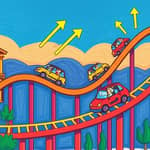
Debt can feel like an overwhelming tide, pulling individuals and families into an endless cycle of stress and uncertainty. Yet with the right knowledge, plan, and persistence, it’s possible to reverse course and achieve lasting financial freedom.
In 2024, global debt reached $251 trillion, equating to just above 235% of global GDP. Public debt alone stands at $99.2 trillion, while private debt totals $151.8 trillion, marking decades of steady growth.
Since 1974, private debt surged from 80% to 143% of GDP, and public debt jumped from 28% to 93%. Advanced economies now carry total debts near 267% of GDP, while emerging markets experience sharper regional fluctuations. Notably, Lebanon bears a staggering 358% of GDP in national debt, and Japan follows at 256.3%.
These figures underscore a sobering reality: debt levels have stabilized at historically high plateaus, but the burden continues to grow for both governments and households. Recognizing this macro trend helps us appreciate the collective challenge—and the individual opportunity—to reclaim control.
On a personal level, debt manifests in various forms:
High-interest debt is particularly dangerous, as compounding costs can double or triple balances in just a few years. Beyond the numbers, unpaid obligations create emotional turmoil and chronic stress, eroding self-confidence and straining relationships. Late payments damage credit scores, reducing access to favorable loan terms and stalling dreams of home ownership or entrepreneurship.
Escaping the debt cycle requires more than willpower—it demands an actionable blueprint and consistent follow-through. Start with these foundational pillars:
Integrating these elements into a unified plan gives you both clarity and momentum.
Two methods dominate the conversation: the Avalanche and the Snowball. Each offers unique advantages depending on your priorities.
Use online calculators to model both approaches with your actual balances and rates. Choose the path that aligns with your temperament—whether you value swift emotional victories or long-term interest savings.
For many, direct negotiation with creditors can unlock lower rates or flexible payment schedules. Debt collectors increasingly rely on data-driven analytics and multichannel outreach, but you have leverage too: prompt communication and a clear proposal can lead to meaningful concessions.
Consolidation options include personal loans, balance-transfer credit cards, and home equity lines of credit. While these choices can streamline payments and reduce rates, they carry potential fees and credit impacts. Before committing, conduct a thorough cost–benefit analysis.
When DIY efforts hit a wall, reputable credit counseling agencies and nonprofit debt relief organizations provide structured programs with proven success rates. Studies show 74% of enrollees settle at least one account within three years, and nearly 60% resolve half their debts in that timeframe. Choose counselors accredited by the National Foundation for Credit Counseling or similar bodies to avoid predatory practices.
Debt reduction is a marathon, not a sprint. Cultivate sustainable habits:
Remaining disciplined through market fluctuations and personal setbacks demands resilience. Focus on progress over perfection, remembering that every extra dollar you allocate toward debt speeds your journey to freedom.
Empower yourself with tools and support:
Take action today: draft your budget, list all debts, and choose a repayment strategy. Reach out for counseling if needed. Each deliberate step you take turns the tide toward a life free from financial worry.
Your journey to financial freedom begins now. Embrace the process, harness these strategies, and reclaim control of your future.
References













